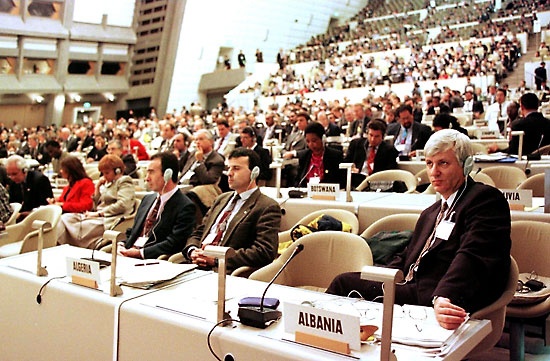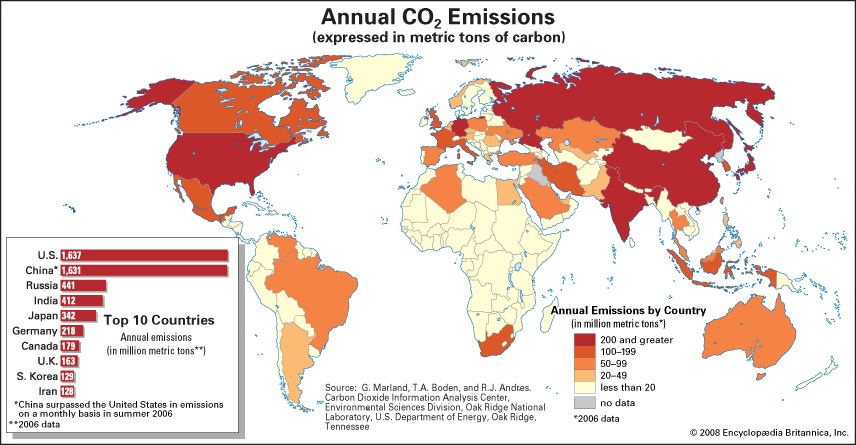Kyoto Protocol
international treaty, 1997
Introduction
in full Kyoto Protocol to the United Nations Framework Convention on Climate Change
 international treaty, named for the Japanese city in which it was adopted in December 1997, that aimed to reduce the emission of gases that contribute to global warming. In force since 2005, the protocol called for reducing the emission of six greenhouse gases (greenhouse gas) in 36 countries to 5.2 percent below 1990 levels in the “commitment period” 2008–12. It was widely hailed as the most significant environmental treaty ever negotiated, though some critics questioned its effectiveness.
international treaty, named for the Japanese city in which it was adopted in December 1997, that aimed to reduce the emission of gases that contribute to global warming. In force since 2005, the protocol called for reducing the emission of six greenhouse gases (greenhouse gas) in 36 countries to 5.2 percent below 1990 levels in the “commitment period” 2008–12. It was widely hailed as the most significant environmental treaty ever negotiated, though some critics questioned its effectiveness.Background and provisions
The Kyoto Protocol was adopted as the first addition to the United Nations Framework Convention on Climate Change (UNFCCC), an international treaty that committed its signatories to develop national programs to reduce their emissions of greenhouse gases. Such gases, including carbon dioxide and methane, affect the energy balance of the global atmosphere in ways expected to lead to an overall increase in global average temperature, known as global warming (see also greenhouse effect). According to the Intergovernmental Panel on Climate Change, established by the United Nations Environment Programme and the World Meteorological Organization in 1988, the long-term effects of global warming would include a general rise in sea level around the world, resulting in the inundation of low-lying coastal areas and the possible disappearance of some island states; the melting of glaciers, sea ice, and Arctic permafrost; an increase in the number of extreme climate-related events, such as floods and droughts, and changes in their distribution; and an increased risk of extinction for 20 to 30 percent of all plant and animal species. The Kyoto Protocol committed most of the Annex I signatories to the UNFCCC (consisting of members of the Organisation for Economic Co-operation and Development (Economic Co-operation and Development, Organisation for) and several countries with “economies in transition”) to mandatory emission-reduction targets, which varied depending on the unique circumstances of each country. Other signatories to the UNFCCC and the protocol, consisting mostly of developing countries, were not required to restrict their emissions. The protocol entered into force in February 2005, 90 days after being ratified by at least 55 Annex I signatories that together accounted for at least 55 percent of total carbon-dioxide emissions in 1990.
 The protocol provided several means for countries to reach their targets. One approach was to make use of natural processes, called “sinks,” that remove greenhouse gases from the atmosphere. The planting of trees, which take up carbon dioxide from the air, would be an example. Another approach was the international program called the Clean Development Mechanism (CDM), which encouraged developed countries to invest in technology and infrastructure in less-developed countries, where there were often significant opportunities to reduce emissions. Under the CDM, the investing country could claim the effective reduction in emissions as a credit toward meeting its obligations under the protocol. An example would be an investment in a clean-burning natural gas power plant to replace a proposed coal-fired plant. A third approach was emissions trading, which allowed participating countries to buy and sell emissions rights and thereby placed an economic value on greenhouse-gas emissions. European countries initiated an emissions-trading market as a mechanism to work toward meeting their commitments under the Kyoto Protocol. Countries that failed to meet their emissions targets would be required to make up the difference between their targeted and actual emissions, plus a penalty amount of 30 percent, in the subsequent commitment period, beginning in 2012; they would also be prevented from engaging in emissions trading until they were judged to be in compliance with the protocol. The emission targets for commitment periods after 2012 were to be established in future protocols.
The protocol provided several means for countries to reach their targets. One approach was to make use of natural processes, called “sinks,” that remove greenhouse gases from the atmosphere. The planting of trees, which take up carbon dioxide from the air, would be an example. Another approach was the international program called the Clean Development Mechanism (CDM), which encouraged developed countries to invest in technology and infrastructure in less-developed countries, where there were often significant opportunities to reduce emissions. Under the CDM, the investing country could claim the effective reduction in emissions as a credit toward meeting its obligations under the protocol. An example would be an investment in a clean-burning natural gas power plant to replace a proposed coal-fired plant. A third approach was emissions trading, which allowed participating countries to buy and sell emissions rights and thereby placed an economic value on greenhouse-gas emissions. European countries initiated an emissions-trading market as a mechanism to work toward meeting their commitments under the Kyoto Protocol. Countries that failed to meet their emissions targets would be required to make up the difference between their targeted and actual emissions, plus a penalty amount of 30 percent, in the subsequent commitment period, beginning in 2012; they would also be prevented from engaging in emissions trading until they were judged to be in compliance with the protocol. The emission targets for commitment periods after 2012 were to be established in future protocols.Challenges
Although the Kyoto Protocol represented a landmark diplomatic accomplishment, its success was far from assured. Indeed, reports issued in the first two years after the treaty took effect indicated that most participants would fail to meet their emission targets. Even if the targets were met, however, the ultimate benefit to the environment would not be significant, according to some critics, since the United States, the leading emitter of greenhouse gases (approximately 25 percent of the total), was not party to the protocol, and China, the second leading emitter, was not required to restrict its emissions because of its status as a developing country. Other critics claimed that the emission reductions called for in the protocol were too modest to make a detectable difference in global temperatures in the subsequent several decades, even if fully achieved with U.S. participation. Meanwhile, some developing countries argued that improving adaptation to climate variability and change was just as important as reducing greenhouse-gas emissions.
- Sir P.G. Wodehouse
- Sir Phelim O'Neill
- Sir Pherozeshah Mehta
- Sir Philip Francis
- Sir Philip Sidney
- Sir Quintin Brand
- Sir Ralph Abercromby
- Sir Ralph Freeman
- Sir Ralph Hawtrey
- Sir Ralph Richardson
- Sir Randal Cremer
- Sir Ranjitsinhji Vibhaji, Maharaja Jam Sahib of Nawānagar
- Sir Ranjitsinhji Vibhaji Nawānagar, Maharaja Jam Sahib of
- Sir Raymond Firth
- Sir Reginald, 1st Baronet Wingate
- Sir Reginald Goodall
- Sir Reginald Wingate, 1st Baronet
- Sir Rex Harrison
- Sir Richard, 1st Baronet Fanshawe
- Sir Richard Anderson Squires
- Sir Richard Arkwright
- Sir Richard Baker
- Sir Richard, Baronet Wallace
- Sir Richard Blackmore
- Sir Richard Branson